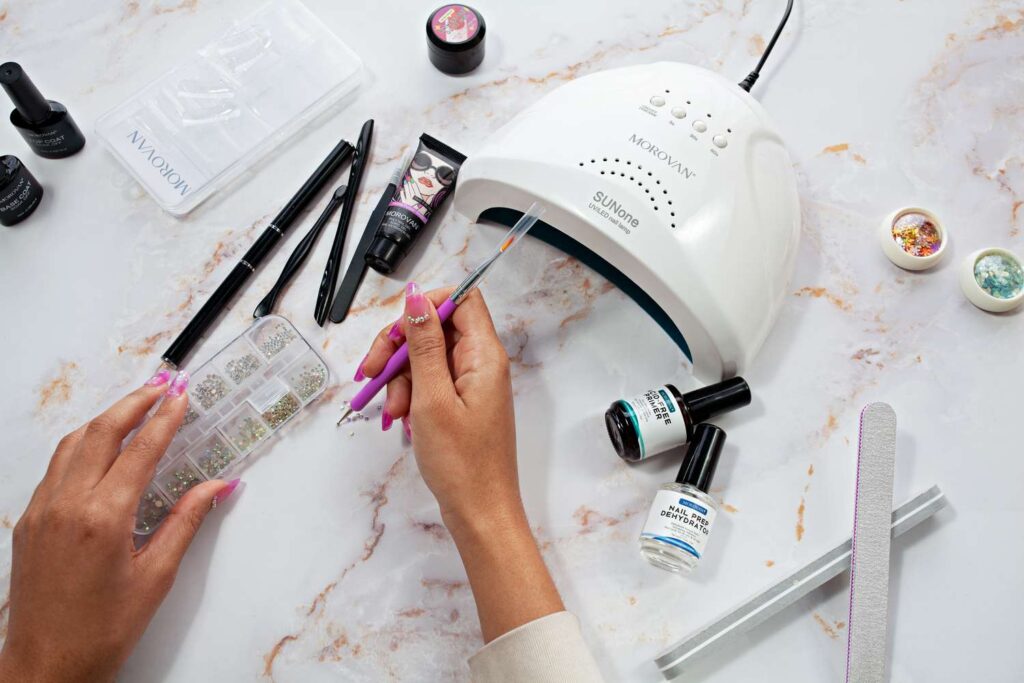The gap between professional salons and home setups has narrowed dramatically over the past few years. What used to require specialized training and expensive equipment is now accessible to regular people who just want nice nails. A salon-style at home nail kit replicates the tools and techniques that nail technicians use, giving you the same level of finish without the $50-70 price tag or two-hour time commitment. Industry data from beauty product manufacturers shows that advanced home kits now include professional-grade UV lamps, gel polish systems, and precision tools that were exclusively commercial-use just five years ago.
The Technology That Changed Everything
LED curing lamps completely transformed home nail care. Earlier UV lamps took 2-3 minutes to cure gel polish and generated heat that made nails uncomfortable. Modern LED lamps cure in 30-60 seconds using specific wavelengths (typically 395-405nm) that activate photoinitiators in gel formulas more efficiently.
The wattage matters here. Professional salons use 36-48 watt lamps, and now home versions match that power. Lower wattage lamps (under 24 watts) don’t cure polish evenly, leading to peeling and chipping within days. Research from polymer chemistry studies shows incomplete curing leaves uncrosslinked monomers that remain tacky and weak.
Gel polish formulas themselves have improved. Salon-quality home kits now include soak-off gels instead of hard gels. The difference is huge—soak-off gels use oligomers that break down with acetone, while hard gels require filing off. This makes removal way less damaging to your natural nails.
Tools That Actually Make a Difference
Electric nail files changed the game for shaping and prep work. Professional-grade e-files operate at variable speeds (0-30,000 RPM) and use different bit types for specific tasks. Carbide bits work for thick acrylic, while fine-grit ceramic bits smooth natural nails without causing heat friction.
But here’s the thing—you need proper technique. Holding an e-file at the wrong angle or pressing too hard can damage the nail plate. Salons teach technicians to use light, sweeping motions and never stay in one spot more than 2-3 seconds.
Quality nail forms and dual forms elevate extension work. Dual forms (clear plastic guides) let you create length using gel without the mess of traditional forms. You fill the form with builder gel, press it onto the nail, cure under the lamp, and remove the form. The result looks identical to salon extensions.
Understanding the Gel System
Base, color, and top coat serve distinct purposes in gel systems. Builder bases contain higher concentrations of oligomers and create structure. They’re thicker than regular base coats and self-level when applied, which is why gel nails look so smooth.
Color gels use pigments suspended in the oligomer matrix. Higher-quality gels have better pigment dispersion, meaning you need fewer coats for opacity. Cheap gels often require 3-4 coats, while professional formulas achieve full coverage in two.
No-wipe top coats save time and hassle. Traditional gel top coats leave an inhibition layer (sticky residue) that needs wiping with alcohol. No-wipe formulas cure to a complete finish, though they’re slightly less glossy. Some kits include both types so you can choose based on the look you want.
Creating the Salon Environment
Lighting setup matters more than you’d think. Nail technicians work under bright, color-corrected lighting (usually 5000-6500K color temperature) because it shows true colors without yellow or blue casts. A simple LED desk lamp with adjustable brightness helps you see what you’re doing and catch mistakes before curing.
Ventilation is something people overlook. Gel polishes release fewer fumes than traditional acrylics, but they still contain chemicals. Working near an open window or using a small desktop fan improves air quality. Some professional kits even include mini nail dust collectors with built-in fans.
Hand positioning tools like silicone nail rests stabilize your hand during detailed work. They seem unnecessary until you try painting your dominant hand without one—suddenly every tiny movement shows up as a wobbly line.
Read More: YWMLFZ 48W Cordless Unleashed: Nail Salon Tech Meets Wireless Innovation
The Learning Curve Reality
Nobody gets perfect results the first time. Salon technicians practice for months. The good news is that gel polish is forgiving during application—you can clean up mistakes before curing. Keep a small brush dipped in rubbing alcohol nearby to fix flooded cuticles or polish that strays onto skin.
Practice on one hand first. Get comfortable with the process, timing, and how the products behave before attempting both hands. Your technique will improve faster this way, and you won’t end up with one great hand and one disaster.



